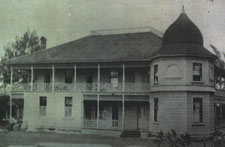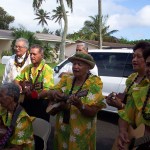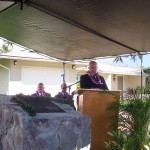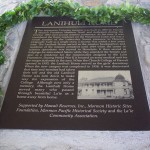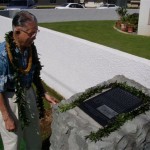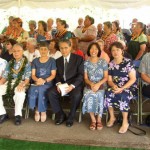Historic Monuments in Laie, Hawaii (2005-06)
The Mormon Historic Sites Foundation has worked with Hawaii Reserves, Inc., the Mormon Pacific Historical Society, and the Laie Community Association to commemorate several buildings of significance in the early history of the Church in Hawaii. MHSF was involved in preparing two markers which were dedicated on July 28, 2006 commemorating the Lanihuli Home and the Social Hall.
The Lanihuli Home was built in 1893 and served as a visual symbol of the Latter-day Saints in Hawaii. It also served as the mission home for the Hawaiian mission until 1919. It was used as a women’s dormitory until it was torn down in 1958 to make room for the expansion of the Church College of Hawaii (now BYU-Hawaii).
The Laie Social Hall was dedicated as a gathering place for the Latter-day Saints on September 30, 1913. It was constructed to hold activities such as dances, plays, and movies. After the Laie Chapel was destroyed by fire, the Social Hall served as the chapel. It was also razed in 1958 with the expansion of the Church College.
Last year, MHSF was involved in a commemorative project where two markers were dedicated as well. First, the LDS Hawaii Mission School was the location where David O. McKay had an experience which led to the establishment of what is now Brigham Young University – Hawaii. It was constructed in about 1915 and the operation of the school was transferred to the Territory of Hawaii in 1927. Second, the Laie Plantation Store was also recognized. The Laie Plantation Store served the Laie community between it’s establishment in 1913 and 1986.

The plantation railroad ran along the west side of the store until 1946 when the railroad was discontinued. With the establishment of the Church College of Hawaii in 1955, Charles K.C. Goo was invited to manage the store. The monuments were dedicated on October 20, 2005 in connection with BYU-Hawaii’s Golden Jubliee Celebration.
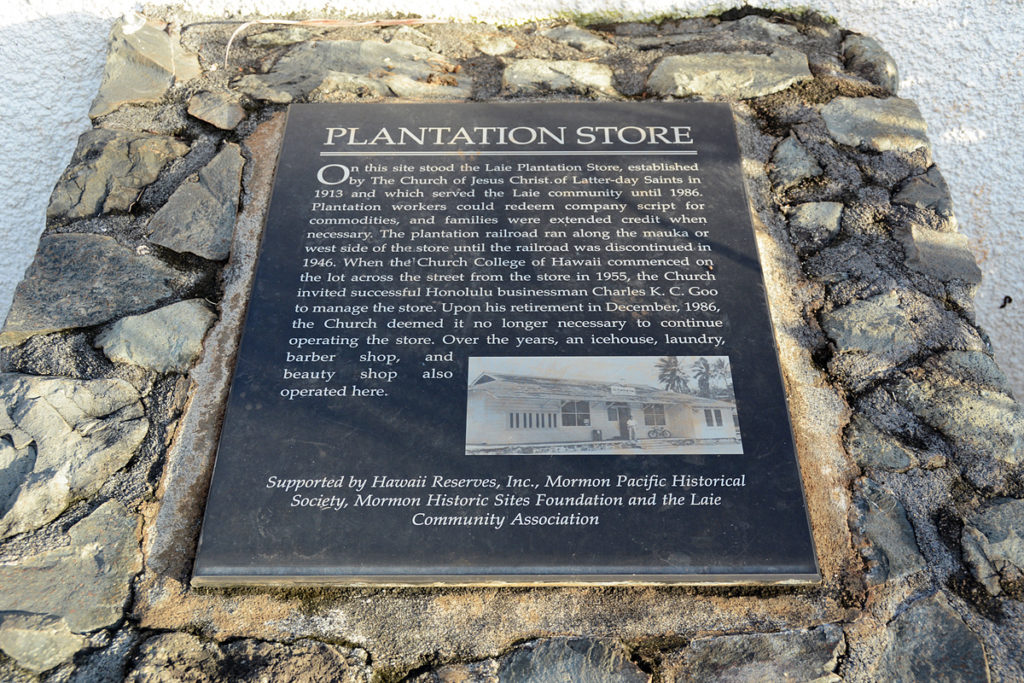
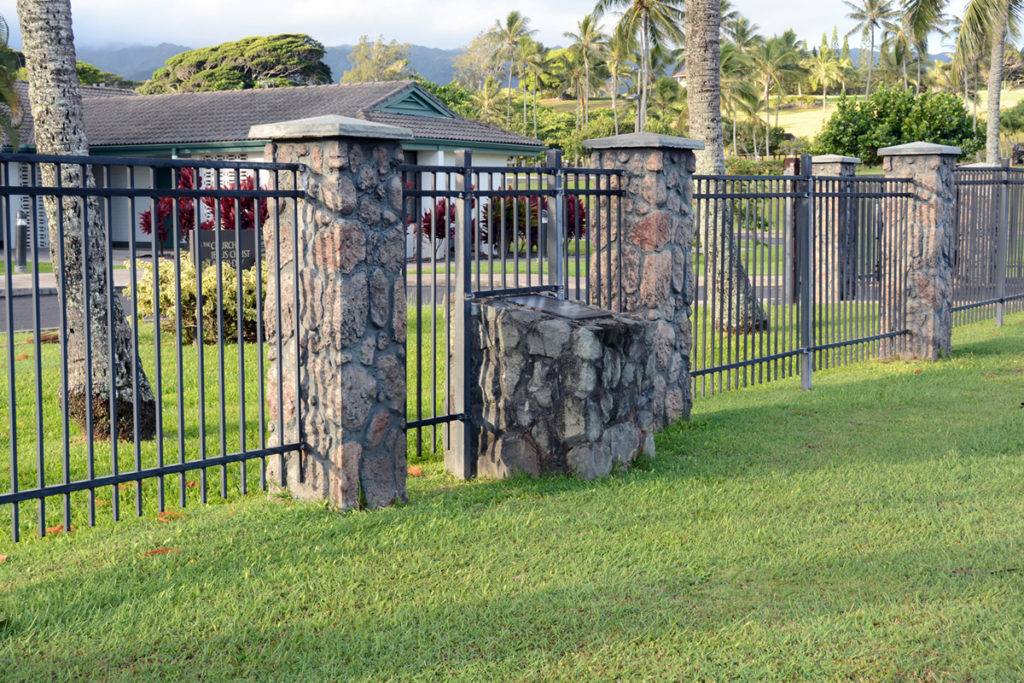
Photos
Articles & Resources
Project revives La'ie's 'heart and soul', The Honolulu Advertiser
Author(s): Eloise Aguiar
Published in: The Honolulu Advertiser
Publication Date: July 27, 2006
Published July 27, 2006. Reprinted with permission from The Honolulu Advertiser.
Project revives La’ie’s ‘heart and soul’
Eloise Aguiar, Advertiser Windward O’ahu Writer, The Honolulu Advertiser

Hawaii Reserves Inc.
LA’IE Only memories remain of two sites that were instrumental in the growth of the Mormon faith in this community, but a project detailing the church’s chronology in Hawai’i will help others learn about their histories.
La’ie leaders affiliated with The Church of Jesus Christ of Latter-day Saints will dedicate historical markers for the Lanihuli Home and the Social Hall as part of an ongoing “historical trail” project that traces Mormon history in the Islands. The free event, at 9 a.m. tomorrow at the top of Lanihuli Street, is open to the public.
The project is sponsored by Hawai’i Reserves Inc. and the Mormon Historical Sites Foundation. Additional support came from the Mormon Pacific Historical Society and the La’ie Community Association.
Gladys Pualoa-Ahuna, 76 and the ninth generation of a La’ie family, said the two buildings were an important part of the community’s social and religious life. Lanihuli, built in 1893, was used as a mission house and visitors who came to the temple stayed there, Pualoa-Ahuna said. But during World War II, the Hawaiian-Victorian mansion was used as a medical center for the military, she said.
In 1955, when Church College of Hawai’i opened, Lanihuli was used as a dormitory, Pualoa-Ahuna said. Old Army barracks served as temporary buildings until the campus was completed, she said.
The Social Hall, built in 1913, was the center for entertainment, weddings, funerals and even church services after the chapel burned down in 1940, Pualoa-Ahuna said. Every weekend there was a movie, and on Saturday there was a concert with impromptu performances by residents and people from outside the community, she said. After the concert the John Broad Orchestra would play music and everyone would dance, Pualoa-Ahuna said. The kids would be in one corner of the room and the teenagers and adults used the rest of the space, she said.
At exactly 11 p.m. the fun would end and the space was prepared for Sunday services, Pualoa-Ahuna said.
“It was the center of the community all through the war years,” she said.
The markers will forever honor two of La’ie’s great gathering places, said Eric Beaver, president of Hawai’i Reserves Inc.
“The Lanihuli Home and the Social Hall were part of the heart and soul of the community here from the turn of the century, throughout the war years and into the late 1950s,” Beaver said in a press release. “The buildings themselves may be gone, but their legacy lives on in the wonderful memories of our kupuna.”
Lanihuli Home was at the top of Lanihuli Street. The home � once considered the finest in Windward O’ahu � served as headquarters for the Hawai’i Mission until 1919. Mission presidents and their families resided in the great mansion with its octagonal turret, cupola and second-story lanai facing the sea. The house was used as a symbol on the personal stationery of one mission president and became a popular symbol of the church in Hawai’i. Spiritual meetings, as well as church business, were conducted there. The home was razed in 1958 to make room for Church College of Hawai’i.
The new markers are being added to a church historical trail in Hawai’i that includes the LDS Mission School and old Plantation Store in La’ie, as well as the Palawai marker on Lana’i, which is a reminder of the first official gathering place for Latter-day saints in the Pacific.
Reach Eloise Aguiar at eaguiar@honoluluadvertiser.com.
Historical trail, LDS Church News
Author(s): Mike Foley
Published in: LDS Church News
Publication Date: October 29, 2005
Published October 29, 2005. Reprinted with permission from LDS Church News published by the Deseret Morning News.
Historical Trail
New plaques mark sites of Church history in Hawaii
Mike Foley, Church News contributor
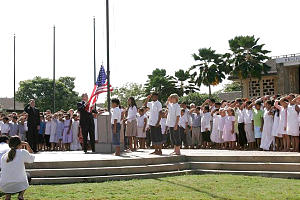
Photo Courtesy Mark A. Philbrick/BYU
LAIE, Hawaii An ongoing “historical trail” project that highlights Church history in Hawaii now includes two new markers here.
The small markers the first, near the Laie 1st Ward chapel, recognizes the site of the Church mission school, and the second, near the site of the Old Plantation Store were dedicated in services Oct. 20 during the week of the Jubilee activities at BYU-Hawaii.
BYU-Hawaii President Eric B. Shumway, also an Area Seventy, offered the dedicatory prayer during the morning event. The historical trail project is co-sponsored by Hawaii Reserves Inc. and the Mormon Historical Sites Foundation, with support from the Mormon Pacific Historical Society and the Laie Community Association. (A marker at Lanai City was dedicated in 2004; please see Oct. 16, 2004, Church News.)
“Laie has a unique and rich history,” said President R. Eric Beaver of Hawaii Reserves and president of the Laie Hawaii Stake during brief remarks. “A few years ago the idea came up of pulling it off the shelves of the archives and making it live in the minds and hearts of those who live here.”

Photo Courtesy Mark A. Philbrick/BYU
The first marker at the site of the mission school is where then-Elder David O. McKay of the Quorum of the Twelve witnessed the flag-raising ceremony on Feb. 7, 1921, which led him to envision the establishment of a university in the community. The Laie 1st Ward chapel was originally built with funds raised at the Hukilau and dedicated by Elder Matthew Cowley in 1951.
Riley Moffat, president of the Laie-based Mormon Pacific Historical Society, explained that missionaries including Flora Amundsen, who later married Church President Ezra Taft Benson and their spouses taught all the children of Laie at the school, including two who still live in the area and were in attendance at the dedication program: Haleola Broad Kanahele, 89, and Thomas Nakayama, 92.
Brother Moffat also noted both of the structures were built during a “building boom” sparked by the construction of the new Hawaii Temple starting in 1915.
Jeffrey Walker, president of the Mormon Historical Sites Foundation, told the audience he has found “the Lord usually picks some pretty obscure properties,” noting few would have initially stopped at the river’s bend at Nauvoo or the valley of the Great Salt Lake.
“The Lord works the same way in all places. The Lord makes great prophecies to fulfill, but the truth is the groundwork is done by people like you. As we celebrate these things, might we remember the great gifts that we have been given.”
In his dedicatory prayer, Elder Shumway asked that community residents rededicate themselves “to what we should be, must be, in order to carry forward the wonderful visions and prophecies spoken by Thy prophets on this hallowed ground.”
He also prayed that visitors would “have a sense this is a hallowed place,” and that the “significance of Laie is not only contained in the tiny environment of the community, but actually extends outward into the whole world.”
“Laie has become a training ground for leaders from all over the world, who will train here, and go back out into the world and bless the lives of millions.”
Mormon landmarks celebrated, The Honolulu Advertiser
Author(s): Eloise Aguiar
Published in: The Honolulu Advertiser
Publication Date: October 21, 2005
Published October 21, 2005. Reprinted with permission from The Honolulu Advertiser.
Mormon landmarks celebrated
Eloise Aguiar, Advertiser Windward O’ahu Writer, The Honolulu Advertiser
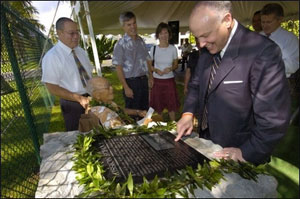
Photo Courtesy Bruce Asato of The Honolulu Advertiser
LA’IE Informational markers were unveiled yesterday at the sites of the old Mission School and the La’ie Plantation Store, as part of an ongoing “historic trail” project to highlight the history of the Church of Jesus Christ of Latter-day Saints in Hawai’i.
The project is co-sponsored by Hawai’i Reserves Inc. and the Mormon Historic Sites Foundation, with additional support from the Mormon Pacific Historical Society and the La’ie Community Association.
The two markers are the second and third to be erected in the Islands, said Eric Beaver, president of Hawai’i Reserves, the land-management arm of the LDS Church in Hawai’i. The first marker is on Lana’i, he said.
La’ie is rich in LDS history, Beaver said, but much of it is on bookshelves and in archives. “We’re thinking maybe we can get that off the shelves and pull it out of the ground and bring it to life,” he said. “There’s talk about putting up a few markers all around Hawai’i.”
Each marker has a plaque explaining the significance of the site.
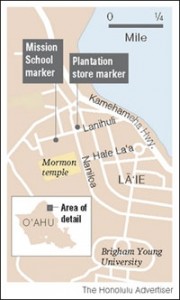 A flag-raising ceremony at the Mission School in 1921 inspired young missionary David McKay to envision the development of an institution of higher learning for the young students at the ceremony, Beaver said.
A flag-raising ceremony at the Mission School in 1921 inspired young missionary David McKay to envision the development of an institution of higher learning for the young students at the ceremony, Beaver said.
Some 30 years later, when McKay became president of the church, he supported the construction of Church College of Hawai’i now Brigham Young University-Hawai’i at the site of the Mission School, he said.
The plantation store was established by the church in 1913 and was the town center for the community it had a jukebox, and was where people came to buy a soda pop and hang out, he said. The store closed in 1986.
“It was a happening place for college kids,” Beaver said.
The Mormon Historic Sites Foundation, which is not part of the church, is considering other locations in La’ie and Nu’uanu for markers and also looking into constructing replicas, but nothing has been decided yet, he said.
Reach Eloise Aguiar at eaguiar@honoluluadvertiser.com.

